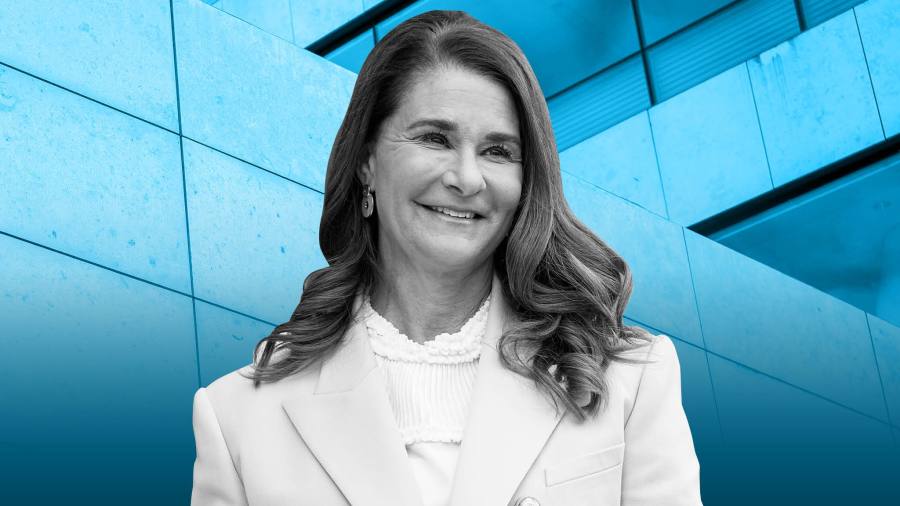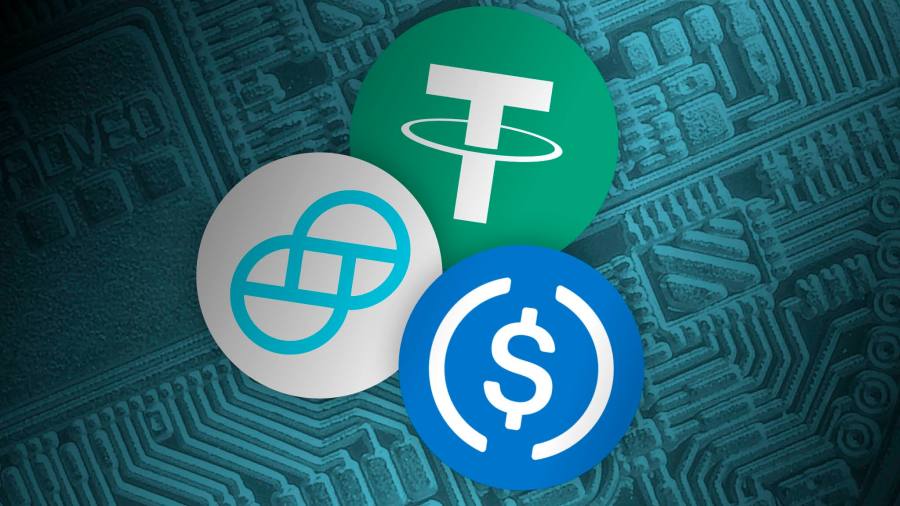[ad_1]
It was April 2019 and Melinda French Gates was touring to promote her book, The Moment of Lift: How Empowering Women Changes the World, when she opened a window into her marriage to Microsoft co-founder Bill Gates.
The hardest things to write about, she confided to an interviewer from CNBC, were “moments in our marriage where I was asking Bill for more equality”. Her story, she said, was “also the story of millions of women”.
A few months later, Melinda would do something unhappily familiar to many millions of women: she consulted a divorce lawyer. Then this May the Gateses announced, via Twitter, that they were ending their 27-year union. They were doing so, they explained, “because we no longer believe we can grow together as a couple in the next phase of our lives”.
The story appears to be more complicated than that. Melinda’s decision to seek counsel came just after a report in The New York Times detailing Bill’s relationship with Jeffrey Epstein, the financier who killed himself in a Manhattan prison cell in 2019 while awaiting trial on charges that he trafficked under-age girls for sex. Bill has said he regretted the relationship, and that he only met Epstein to discuss philanthropy. Still, it was, to say the least, an association jarringly at odds with The Moment of Lift’s message.
Like so many marriages — and divorces — the intricacies of the Gateses’ union are a mystery to those outside it. But unlike others, the Gateses’ rupture is a matter of global interest and has far-reaching consequences, given their immense wealth and public profile.
Over the past 21 years they have built a $55bn philanthropy juggernaut that is not just bigger than others in the sector but virtually a category unto itself. In 2019 the Bill & Melinda Gates Foundation made $5bn in grants — nearly 10 times the amount of the next largest US foundation.
It has championed vaccines with the modest goal of ending childhood mortality and eradicating diseases like polio. Over the past year, in particular, the Gateses have become a familiar and soothing presence in living rooms around the world, helping television viewers understand a terrifying new pandemic and how it may eventually be brought under control.
When announcing their break-up, Bill and Melinda insisted they still believed in the Gates Foundation’s mission — to help all people lead healthy, productive lives — “and will continue this work together”.
Despite the promises of an amicable split, each has assembled an armada of divorce lawyers. In the tightly-controlled world of the Gates Foundation there are now murmurs of dissent and doubts about whether the organisation can hold together as currently constituted.
“I think people are freaking out a little bit,” one former senior executive said soon after the announcement. “People are really worried that the credibility and standing of the foundation is in jeopardy now, especially in areas like gender empowerment.”
Those anxieties deepened after Warren Buffett, the Gateses’ close friend who has pledged the bulk of his fortune to the foundation, announced late last month that he was resigning as its third trustee. Then last week the Gateses dropped another bombshell: if either decides after two years they can no longer work together, they said, then Melinda will resign and Bill will provide “personal resources” for her to pursue her own philanthropy.
That announcement has only added to the speculation around Melinda, and what her next chapter holds. Over the years she has progressed from an intensely private, behind-the-scenes figure to a leader comfortable in the spotlight and increasingly possessed by a singular cause.
“I want to see more women in the position to make decisions, control resources, and shape policies and perspectives,” she declared in Time magazine in October 2019 — around the time she was consulting divorce lawyers — as she pledged to invest $1bn to support gender equality. Speaking at Harvard University last month, after she was awarded its Radcliffe Medal, Melinda professed her admiration for other emblems of female empowerment, the late Supreme Court Justice Ruth Bader Ginsburg and former US secretary of state Hillary Clinton.

“Clearly she had a very different perspective [from Bill],” says Martin Levine, a consultant who has long followed the Gates Foundation, pointing to a conflict between the prototypical smartest man in the room — whose Microsoft fortune gave rise to the foundation — and his wife’s “emerging sense of empowerment”.
A former executive also sensed a potential for rivalry. “She must have felt some of that pressure to show she was an equal,” this person says. “There were times he was so dismissive of everyone in the room, including her.”
Melinda now joins Laurene Powell Jobs and MacKenzie Scott, formerly Bezos, in a unique club: they are tech billionaires’ former spouses who are suddenly unbound and free to chart their own philanthropic course.
“She has the ear of leaders and she can get to talk to G7 finance ministers, but also she’s the person who can interact deeply on the ground. I mean, watching her in the field — she’s an amazing, very empathetic listener,” Mark Suzman, the foundation’s chief executive, said of his boss’ talents.
“She’s going to be a force,” a former adviser predicted, “and the world will benefit.” In her argot, Melinda is preparing for lift-off.
Go north-west
Long before she met her husband, Melinda French had experience of brainy men who toil long hours outside the home, leaving the burden of child rearing to their wives. Her father, Raymond, was an aerospace engineer in Dallas who worked on the Apollo missions that eventually put the first man on the moon. (Hence, the “moment of lift”).
Friends insist that, in private, the hyper-prepared Melinda is fun — as if this were inconceivable. (Melinda, meanwhile, long insisted in interviews that Bill had a tender heart, as if that were inconceivable).
She gives the impression that she is less enthralled by her vast wealth than she is coexisting with it. Often she tamps down its trappings to make social encounters less awkward. Among her greatest pleasures, she has said, are Monday morning walks with a close circle of girlfriends.
She remains an avid reader of spiritual writers like Mark Nepo, author of The Book of Awakening. An early touchstone in her life was Ursuline Academy, the all-girls Catholic school in Dallas where Melinda attended mass five days a week.
It was at Ursuline that Melinda used an early Apple computer to learn programming. She went on to Duke University, where she crammed a degree in computer science and a masters in business administration into just five years.
Upon graduation in 1986 she appeared destined for an established multinational such as IBM. But a female executive there warned her that a woman could only go so far at such an established company. She would do better at Microsoft, then still a young and fast-growing software company in Seattle.

So Melinda headed north-west and encountered a world-changing company that was exciting but also unsettling. Colleagues did not just challenge one another in internal meetings — they tore each other to shreds, often seeking to imitate Bill. Like other women of that corporate era, Melinda sought allies and fretted about whether such an office culture could ever stretch to accommodate her.
About six months after arriving, she started dating Bill Gates.
Though Bill drew up a list of pros and cons on a whiteboard before proposing to Melinda, he later described their courtship in romantic terms that evoked F Scott Fitzgerald’s jazz-age classic, The Great Gatsby. “When we were first dating she had a green light that she would turn on when her office was empty and it made sense for me to come over,” Bill recounted in Davis Guggenheim’s 2019 Netflix documentary, Inside Bill’s Brain. It was a homage to the green light at the end of Daisy’s dock that draws Gatsby in.
Others who saw them interact had a less rosy view of the atmosphere at the company and the relationship. One former Microsoft adviser, who found that its culture of arrogance and entitlement outstripped anything else in the emerging tech world, adds: “I remember everyone being shocked when they got engaged. People thought she was smarter than that. But she knew exactly who she was marrying.”
Melinda started out as a product manager for Microsoft Word. She went on to oversee the launch of its Encarta online encyclopedia, among other projects, eventually managing 1,700 people. She left the company in 1996 after the first of their three children was born, and — in spite of the Gateses’ resources — succumbed to the same loneliness and despair familiar to other new mothers. Her sense of isolation was compounded by the fact that the Gateses were moving into a vast new house Bill had commissioned before they married in 1994.
Foundation mission
The Gates Foundation, which they launched in 2000, the year that Bill stepped down as Microsoft chief executive, was a means to channel the family’s vast wealth to address the great public health challenges of the age, using Microsoft’s smarts and ambition.
While it has largely been lauded for its good works, the foundation has also attracted criticism for some of the same unappealing traits commonly associated with Big Tech: the sense that its executives think they are smarter than others, and a sometimes domineering approach. With its size and lobbying muscle, for example, the foundation pushed controversial changes to US education policy, including smaller schools and more testing — only to admit years later that there was scant evidence these had improved matters.
“They’re like a tech company,” Levine says. “They’re quick to get in, and quick to get out.”
The Foundation softened Bill’s public image after his petulant performance at 1998 Congressional hearings investigating Microsoft’s anti-competitive practices. It also became the arena in which the Gateses wrestled to find a more equal footing in their marriage.
Melinda writes extensively about this challenge in The Moment of Lift. The book is both personal biography and a travelogue of her visits to impoverished corners of the earth where her encounters with women give rise to insights on public health and spiritual growth. It would sit comfortably on a bookshelf beside Clinton’s It Takes a Village and Sheryl Sandberg’s Lean In.
“To me, no question is more important than this one: does your primary relationship have love and respect and reciprocity and a sense of teamwork and belonging and mutual growth? I believe all of us ask ourselves this question in one way or another — because I think it is one of the greatest longings of life,” she writes.

At one point Melinda says she complained to a friend of feeling “invisible” even while working alongside Bill.
The pair and their advisers studiously insist they have been equals at the foundation, where they work out of connecting offices. Suzman says of their working relationship: “Bill and Melinda sit at the end of a very long table in our conference room together and agree and make the decisions based on the inputs of often very vigorous discussions.”
But in the early days some staff did not always view the co-chairs as such. “There was a culture of wanting to please the parents, if you will, that created an environment where everybody was managing up to try to impress the co-chairs. And I think Bill probably got more of that attention just because of who he is than Melinda did,” one recalls.
Their approaches also differed. “You hear a lot about her being the human influence and that was certainly my perspective,” says Greg Ratliff, who spent a decade at the Gates Foundation working on education and is now a senior vice-president at Rockefeller Philanthropy Advisors. “Bill loved the education technology tools and how they worked and how they accelerated learning — or didn’t. And Melinda cared more about what was the student experience? And how usable was it for teachers?”

If there was a defining moment in her gradual emergence as a public figure, it was the 2012 London Summit on Family Planning. She chaired the event, commanding the stage alongside then Prime Minister David Cameron and other world leaders. During a confident keynote address Melinda professed her conviction that contraceptives must be made widely available to women and pledged more than $1bn to the cause — provoking criticism from the Catholic Church.
“I think you know Bill and I are both big believers in innovation. That’s what drew us both to computer technology in the first place,” she said. “But today what I’m excited about is joining with you all to innovate on behalf of women. This, for me, is new, and this is exciting.”
Behind the scenes, there was a more subtle change that year. Melinda asked to co-author the annual letter Bill drafted for the foundation’s stakeholders. While it might seem a trivial matter, the letter is regarded within the foundation as a sort of State of the Union address. Bill resisted, arguing that the status quo appeared to be working just fine, according to Melinda’s recounting. Eventually, he consented to her writing an essay about her recent trip to Niger and Senegal that would be included in his larger note. The next year she had a bigger role. Then the following year she gained full equality as co-author.

Solo venture
In 2015 came another development, which some observers now regard as a step towards the Gateses’ eventual separation: Melinda launched her own investment vehicle, Pivotal Ventures, dedicated to women’s causes. In keeping with her cautious style, it launched without a press release or fanfare, and only came to light because some tech reporters stumbled on its website. Tellingly, it described Pivotal as “a Melinda French Gates Company” — a rare inclusion at the time of her maiden name.
Among the staff of 12 was one of Melinda’s closest advisers: Catherine St-Laurent, a communications specialist who later worked with Meghan Markle and Prince Harry on their new foundation.
Pivotal now has a staff of about 90 and its own headquarters just across Lake Washington from the Gates Foundation. It has made more than 150 investments — both venture capital and philanthropic — all with the intention of closing the gender gap in the public and private sector. One is Ellevest, a financial management platform geared towards women whose chief executive is Sallie Krawcheck, the former Wall Street executive. A person close to Melinda describes Pivotal as “a place where she could think differently”. That is, it was hers.
“She really believes women are the fulcrum,” explains a former foundation executive who was close to Melinda.

Post-divorce, some speculate that Pivotal will become Melinda’s primary interest. Bill has his own venture fund that focuses on breakthrough clean energy technologies.
Among Pivotal’s bets is a $40m “Equality Can’t Wait” initiative, which was funded last year with the recently-divorced Scott to provide grants to groups with transformational ideas to improve gender equality. Since divorcing Jeff Bezos, the Amazon founder, two years ago, the novelist has given away nearly $9bn, while shunning the limelight and seeming almost embarrassed she cannot rid herself of the money more quickly.
However Melinda proceeds, the question is whether she will be able to make the same impact without Bill, whose fortune enabled their initial lift. Then again, there may be benefits to standing on her own.
As Melinda once wrote: “I’ve been trying to find my voice as I’ve been speaking next to Bill — and that can make it hard to be heard.”
[ad_2]
Source link


